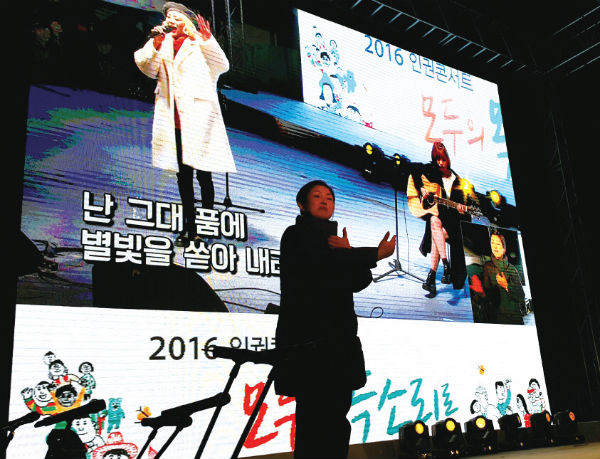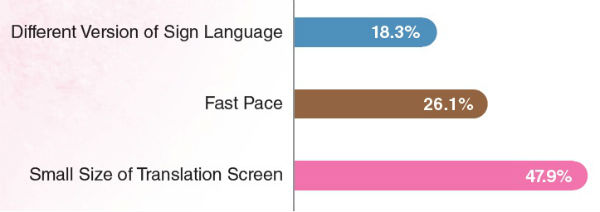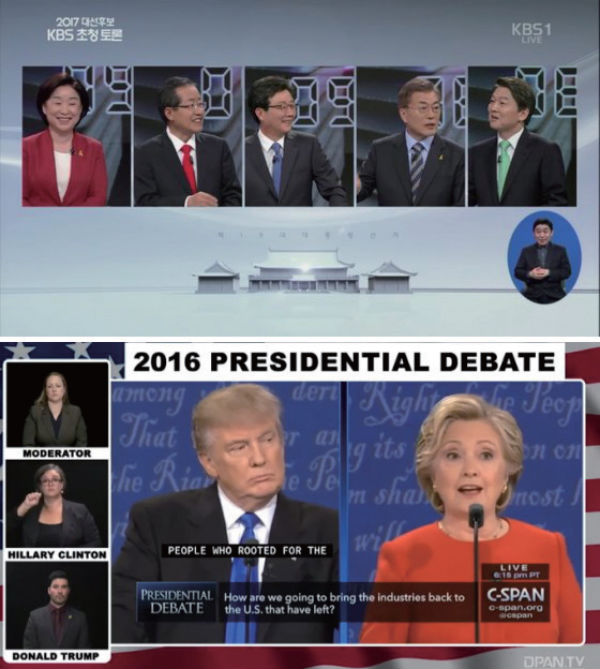There are various languages in the world. Among them, there is also sign language, which is a language that is not expressed with voices. Perhaps some Kingos have learned how to sign a song or sign their own names in sign language through school activities and recreational programs. Likewise, sign language exists around us and is not unfamiliar in our daily lives. Sign language interpreters are people who professionally serve as a bridge between hearing people and deaf people. In this article, the Sungkyun Times (SKT) will introduce sign language interpreters in Korea, and highlight their straightforward stories based on their real-life experiences through an interview.
Sign Language Interpreters in Korea
Wider Roles of Sign Language Interpreters
Nowadays, sign language interpreters do not exist only for interpretation between the deaf and the hearing. Interpreters’ roles affect our society broadly.
Political and Social Roles
The Korea Deaf Association and the Association of the Deaf work to induce deaf people’s political and social participation by forming volunteer groups of sign language interpreters. These groups of interpreter volunteers were made to help deaf people’s political and social activates. Recently, sign language interpreters have been joining candlelight rallies. Last year, there was a large scale candlelight rally held in Korea over the course of a year. After the first rally, many deaf people felt the necessity for translations during the rally. Consequently, lots of sign language i n t e r p r e t e r s h a v e joined the rally, and volunteered to help the deaf with translation, which has become a big issue in the Social Network Services (SNSs). Above all, the 20th candlelight rally was the most viewed across the SNSs. At the 20th rally, singers such as Insunnie, and Jo PD performed, and sign language interpreters performed with them interpreting the lyrics of their songs. As the number of the participators increased, interpreters who participated in the rally said that the number of deaf at the rallies grew, and also became more active.

Cultural Roles
There have been lots of concerts for the deaf being held with the help of sign language interpreters. Because of the stereotype that concerts are only for hearing people, the deaf have been placed in the blind spot of cultural life. Challenging this stereotype, sign language interpreters have volunteered to translate the lyrics into sign language to help the deaf enjoy concerts. Thanks to the help of interpreters, the deaf can enjoy performances such as musicals, indie band concerts, and DJ parties that they could not fully have enjoyed in the past because of the lack of interpretation. Sign language interpreters contributed to the appearance of the stages in which the deaf can actively communicate. Furthermore, the interpreters help resolve the misunderstanding between the hearing and people with hearing disabilities.
Circumstances in Korea
To become a sign language interpreter in Korea, it is necessary to pass the national accredited certification examination. Only a person who passes this exam can be registered as a national sign language interpreter. Most sign language interpreters are assigned to the sign language interpreter center of each local authority. The scope of activities includes giving sign language lectures, being dispatched according to personal requests, and doing national level volunteering such as helping hearing-impaired college students. Approximately 1,000 national sign language interpreters are currently working in Korea.
Improvements Needed for Sign Language Interpreters
Shortage of Numbers
Sign language interpreters claim that a limited number of interpreters is one of the crucial problems that needs to be solved. The sign language interpreter qualifying examination has been held for less than 30 years. Thus, sign language interpreters are lacking nationally. The number of deaf people per one sign language interpreter has reached 327 nationwide. In particular, in Incheon city, which shows the lowest figures nationwide, one interpreter has to take care of 1193 deaf people. The big reason for this deficiency is that the tight budgets are assigned to the interpreters. Budgets are organized at each local authority level and paid to sign language interpreters. Therefore, if the government is under a certain local city with very limited budget, then there would be fewer interpreters being assigned. There is also a shortage of college majors which are related to sign language. Even though, there might be quite a few number of students whose goals are to become sign interpreters, there are only two colleges which have a department of sign language.
Incomplete Establishment of Standard Sign Language
After the Korea Sign Language Law was established, there were voices arguing that the establishment of a standard sign language was needed. Before the law was established, however, there were no certain standard rules for using sign language. For that reason, there are multiple versions of sign language that are used according to people’s environment. In particular, there are great gaps between ages. Thus, when interpreters translate sign languages, they must translate considering a person’s background. Moreover, there are issues establishing newly-coined words into sign language since there are no accurate standards. Before a newly-coined word becomes popular, there are distinctions between sign languages that interpreters and deaf people use.
Sign Language in Broadcasting
Small Number of Sign Language Broadcasts
According to the rules of organization and guarantee of broadcasts for the disabled, each broadcaster should guarantee certain amount of broadcasting time that includes translations for the deaf. In 2017, the disabled broadcast duty ratio was 100% of closed captioning broadcasts, 10% of descriptive video services, and 5% of sign language broadcasts. It is true that there are few organizations which are in charge of sign language broadcasting. Even though 5% of the total broadcasts are being signed, according to the National Institute of Korean Language, the rate of the people who understand sign language broadcasting completely is only 11.4%. It is because the translations are too fast or interpreters are using a completely different version of sign language. In the section of sports broadcasting, broadcasters are able to organize sign language broadcasts, but it can be regulated autonomically by each broadcaster in accordance with copyright and balance with the common screen.

Presidential TV Debate Broadcast
Even though deaf people are free to vote, currently t h e Public Off i c i a l Election Act does not regulate sign language broadcasting as a duty. On the presidential TV debate, which started on April 13th, there was only one sign language int e rpr e t e r t aking charge of translating all five candidates at a time. The interpreter on the debate broadcast said that he had to interpret two candidates at the same time. Nuri, a disability civic group, complained to the broadcasters and the Central Election Management Committee that many of the deaf did not understand the contents of the debate properly. It was argued that one interpreter’s taking on translating more than two candidates at the same time is discrimination to the deaf. Lots of deaf and sign language interpreters claimed that the regulations of debate broadcast for the deaf should be changed.

Interview

Please introduce yourself.
My name is Kang Yeon-joog, and I have been working as a sign language interpreter for 16 years at the Nowon-Gu Office. I first encountered sign language when I worked at the Geumgang Company about 30 years ago. There were a lot of deaf people working there and while I was working with them, I started learning sign language with both curiosity and sympathy towards them. Now I am a professional sign language interpreter.
Sign language is a language which does not include sound, unlike spoken language. What do you think is the special charm of sign language?
I often compare sign language to a piece of drama or a movie. When you look at the origin of sign language, you need all kinds of imagination to express the shape and sound of the word. Many people, who use sign language including me, regard sign language as a true art. Even though sign language has no sound, when you look at people speaking with sign language, it is really impressive to see words flying around back and forth.
What was the most rewarding moment while you were interpreting?
Sign language interpreters give help in various circumstances, such as, when deaf people need interpretation at court or a police station. We also help them when they have meetings with their children’s teacher, check up at hospitals and even when they are having blind dates. Among them, the most rewarding moment was the time when I interpreted a mother giving birth. I went into the delivery room, and helped her until the child was born. I still cannot forget the moment when the child was born.
It has been a long time since you have been working as a sign language interpreter. What is the biggest problem or hardship you went through while you were translating?
Actually, interpreting sign language is not that hard. The biggest problem is the severe shortage of sign language interpreters. At Nowon-Gu office, where I am currently working, there are almost 600 requests for translation per month on average. Because I take care of all the requests, it is hard for me to give absolute explanation to the deaf. If I only concentrate on helping one request, then other requests will have to wait a tremendously long time. Like this, I should fight the clock all the time.
What do you think should be done at the government level for a better welfare for the deaf?
First of all, I think it is important to increase the number of sign language interpreters. Moreover, I would like to see broader job opportunity for deaf people. These days, Korea is experiencing serious unemployment, which makes it even more difficult for the deaf. Personally, I would like to suggest that if the employers hire deaf employees for deaf customers, the employers can provide jobs to the deaf and also the deaf will find it more convenient in receiving the service.
Any last words for the Kingos?
The pearl is hiding in the shell, isn’t it? I think deaf people are like pearls hidden in glass shells. The pearl is visible from the outside. However, there is a glass wall called sign language. Just like most people who are beautiful pearls in shells, the deaf are also beautiful pearls in shells whose only the difference is having this glass wall. I wish all Kingos to take out the pearls hidden in these glass shells and give deaf people the opportunity to show their various abilities.
There are seven billion people living on Earth. Among all these people, no one will probably live with the same life style. Some of them are living lives without any sound, but are constantly trying to communicate with others in society through their own ways of expressing themselves. We have learned in school or in books that living together and understanding other social members is important. Considering this, the role of sign language interpreters who connect us with those who cannot hear is crucial. Increasing the number of sign language interpreters and improving their working environment is not just for the deaf. Now it is time for us to speak out to improve our society and make a better place to live for everyone.
